fuel cap TOYOTA CAMRY HYBRID 2021 Owners Manual (in English)
[x] Cancel search | Manufacturer: TOYOTA, Model Year: 2021, Model line: CAMRY HYBRID, Model: TOYOTA CAMRY HYBRID 2021Pages: 624, PDF Size: 15.98 MB
Page 3 of 624
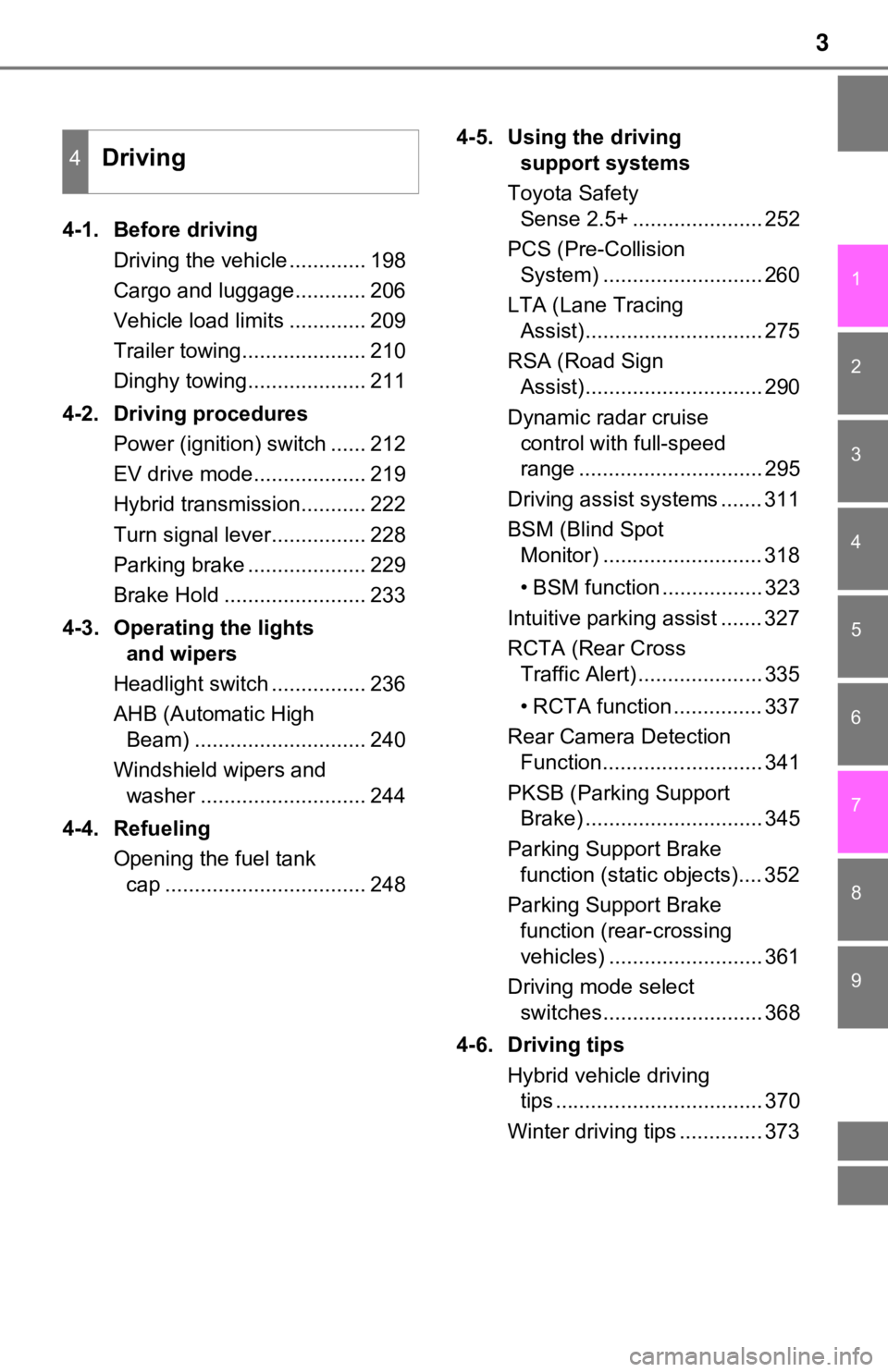
3
1
9 7 6
5
4
3
2
8
4-1. Before drivingDriving the vehicle ............. 198
Cargo and luggage............ 206
Vehicle load limits ............. 209
Trailer towing..................... 210
Dinghy towing.................... 211
4-2. Driving procedures Power (ignition) switch ...... 212
EV drive mode................... 219
Hybrid transmission........... 222
Turn signal lever................ 228
Parking brake .................... 229
Brake Hold ........................ 233
4-3. Operating the lights and wipers
Headlight switch ................ 236
AHB (Automatic High Beam) ............................. 240
Windshield wipers and washer ............................ 244
4-4. Refueling Opening the fuel tank cap .................................. 248 4-5. Using the driving
support systems
Toyota Safety Sense 2.5+ ...................... 252
PCS (Pre-Collision System) ........................... 260
LTA (Lane Tracing Assist).............................. 275
RSA (Road Sign Assist).............................. 290
Dynamic radar cruise control with full-speed
range ............................... 295
Driving assist systems ....... 311
BSM (Blind Spot Monitor) ........................... 318
• BSM function ................. 323
Intuitive parking assist ....... 327
RCTA (Rear Cross Traffic Alert) ..................... 335
• RCTA function ............... 337
Rear Camera Detection Function........................... 341
PKSB (Parking Support Brake) .............................. 345
Parking Support Brake function (static objects).... 352
Parking Support Brake function (rear-crossing
vehicles) .......................... 361
Driving mode select switches........................... 368
4-6. Driving tips Hybrid vehicle driving tips ................................... 370
Winter driving tips .............. 373
4Driving
Page 15 of 624
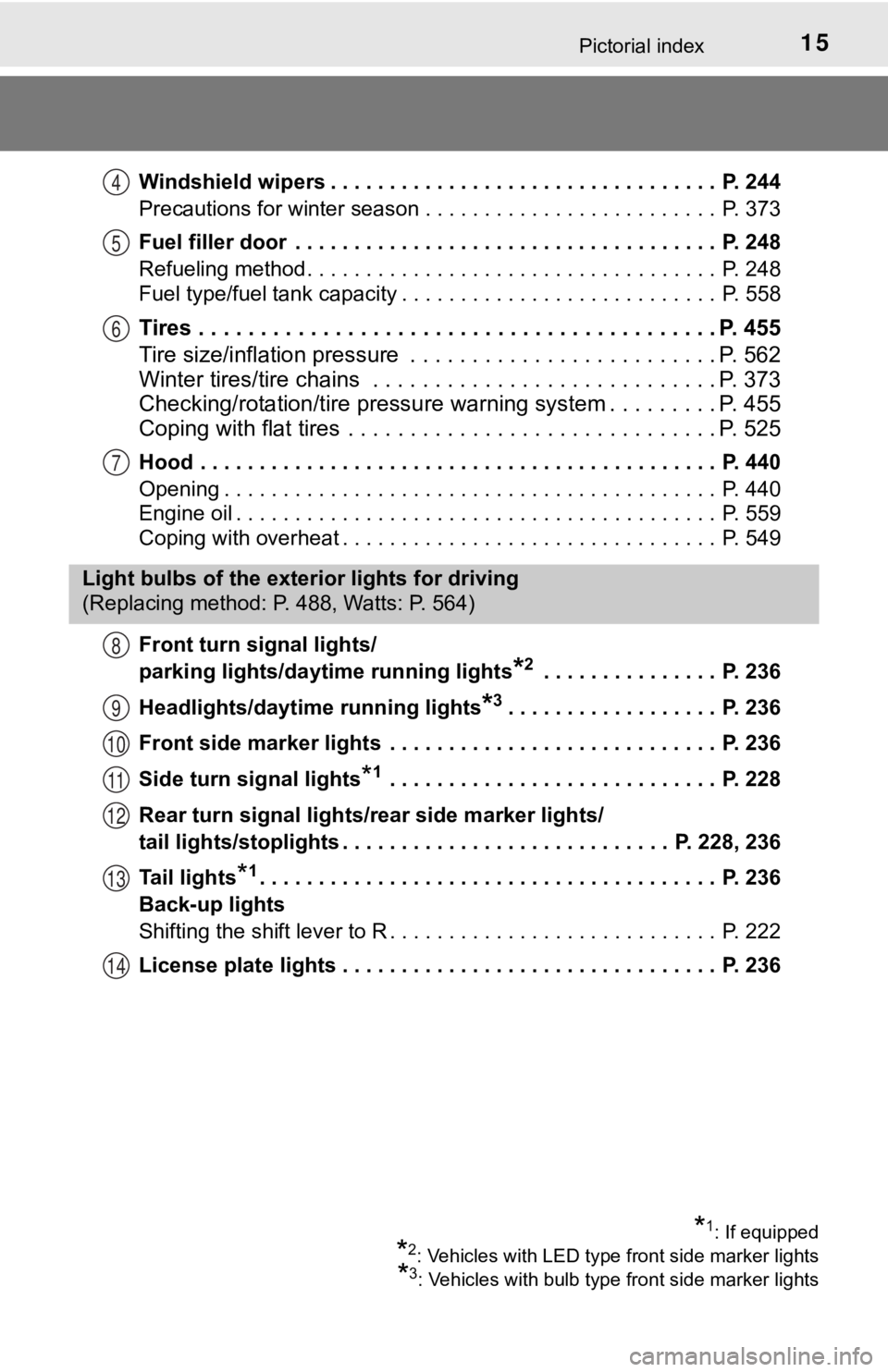
15Pictorial index
Windshield wipers . . . . . . . . . . . . . . . . . . . . . . . . . . . . . . . . . P. 244
Precautions for winter season . . . . . . . . . . . . . . . . . . . . . . . . . P. 373
Fuel filler door . . . . . . . . . . . . . . . . . . . . . . . . . . . . . . . . . . . . P. 248
Refueling method . . . . . . . . . . . . . . . . . . . . . . . . . . . . . . . . . . . P. 248
Fuel type/fuel tank capacity . . . . . . . . . . . . . . . . . . . . . . . . . . . P. 558
Tires . . . . . . . . . . . . . . . . . . . . . . . . . . . . . . . . . . . . . . . . . . P. 455
Tire size/inflation pressure . . . . . . . . . . . . . . . . . . . . . . . . . P. 562
Winter tires/tire chains . . . . . . . . . . . . . . . . . . . . . . . . . . . . P. 373
Checking/rotation/tire pressur e warning system . . . . . . . . .P. 455
Coping with flat tires . . . . . . . . . . . . . . . . . . . . . . . . . . . . . . P. 525
Hood . . . . . . . . . . . . . . . . . . . . . . . . . . . . . . . . . . . . . . . . . . . . P. 440
Opening . . . . . . . . . . . . . . . . . . . . . . . . . . . . . . . . . . . . . . . . . . P. 440
Engine oil . . . . . . . . . . . . . . . . . . . . . . . . . . . . . . . . . . . . . . . . . P. 559
Coping with overheat . . . . . . . . . . . . . . . . . . . . . . . . . . . . . . . . P. 549
Front turn signal lights/
parking lights/daytime running lights
*2 . . . . . . . . . . . . . . . P. 236
Headlights/daytime running lights
*3. . . . . . . . . . . . . . . . . . P. 236
Front side marker lights . . . . . . . . . . . . . . . . . . . . . . . . . . . . P. 236
Side turn signal lights
*1 . . . . . . . . . . . . . . . . . . . . . . . . . . . . P. 228
Rear turn signal lights/r ear side marker lights/
tail lights/stoplights . . . . . . . . . . . . . . . . . . . . . . . . . . . . P. 228, 236
Tail lights
*1. . . . . . . . . . . . . . . . . . . . . . . . . . . . . . . . . . . . . . . P. 236
Back-up lights
Shifting the shift lever to R . . . . . . . . . . . . . . . . . . . . . . . . . . . . P. 222
License plate lights . . . . . . . . . . . . . . . . . . . . . . . . . . . . . . . . P. 236
4
5
6
7
Light bulbs of the exter ior lights for driving
(Replacing method: P. 488, Watts: P. 564)
8
9
10
11
12
13
14
*1: If equipped
*2: Vehicles with LED type front side marker lights
*3: Vehicles with bulb type front side marker lights
Page 197 of 624

197
4Driving
4-1. Before drivingDriving the vehicle ............. 198
Cargo and luggage ........... 206
Vehicle load limits ............. 209
Trailer towing..................... 210
Dinghy towing ................... 211
4-2. Driving procedures Power (ignition) switch ...... 212
EV drive mode .................. 219
Hybrid transmission........... 222
Turn signal lever................ 228
Parking brake .................... 229
Brake Hold ........................ 233
4-3. Operating the lights and wipers
Headlight switch ................ 236
AHB (Automatic High Beam) ............................. 240
Windshield wipers and washer ............................ 244
4-4. Refueling Opening the fuel tank cap .................................. 248
4-5. Using the driving support systems
Toyota Safety Sense 2.5+...................... 252
PCS (Pre-Collision System) ........................... 260 LTA (Lane Tracing
Assist) ............................. 275
RSA (Road Sign Assist) ............................. 290
Dynamic radar cruise control with full-speed
range............................... 295
Driving assist systems ...... 311
BSM (Blind Spot Monitor)........................... 318
• BSM function ................ 323
Intuitive parking assist....... 327
RCTA (Rear Cross Traffic Alert) .................... 335
• RCTA function .............. 337
Rear Camera Detection Function .......................... 341
PKSB (Parking Support Brake) ............................. 345
Parking Support Brake function (static objects) ... 352
Parking Support Brake function (rear-crossing
vehicles).......................... 361
Driving mode select switches .......................... 368
4-6. Driving tips Hybrid vehicle driving tips .................................. 370
Winter driving tips ............. 373
Page 200 of 624

2004-1. Before driving
■ECO Accelerator Guidance ( P. 125)
Eco-friendly driving may be achieved more easily by staying wit hin the zone
of Eco acceleration. Also, by staying within the zone of Eco ac celeration, it
will be easier to obtain a good Eco score.
● When starting off:
Gradually depress the accelerator pedal to stay within the zone of Eco accel-
eration and accelerate to the desired speed. By refraining from excessive
acceleration, a good eco start score will be obtained.
● When driving:
After accelerating to the desired speed, release the accelerator pedal and
drive at a stable speed while staying within the zone of Eco acceleration. By
staying within the zone of Eco acceleration, a good eco cruise score will be
obtained.
● When stopping:
By starting to release the accelerator pedal early before dece lerating, a good
eco stop score will be obtained.
■ Drive-Start Control (DSC)
●When the TRAC is turned off ( P. 313), sudden start restraint control also
does not operate. If your vehicle have trouble escaping from th e mud or
fresh snow by operating sudden start restraint control, deactiv ate TRAC
( P. 313) so that the vehicle may become able to escape from the mud or
fresh snow.
■ Breaking in your new Toyota
To extend the life of the vehicle, observing the following prec autions is recom-
mended:
● For the first 186 miles (300 km):
Avoid sudden stops.
● For the first 621 miles (1000 km):
• Do not drive at extremely high speeds.
• Avoid sudden acceleration.
• Do not drive continuously in low gears.
• Do not drive at a constant speed for extended periods.
■ Operating your vehicle in a foreign country
Comply with the relevant vehicle registration laws and confirm the availability
of the correct fuel. ( P. 558)
■ Eco-friendly driving
P. 125, 140
Page 216 of 624

2164-2. Driving procedures
■When the steering lock cannot be released
■ Steering lock motor overheating prevention
To prevent the steering lock motor from overheating, the motor may be sus-
pended if the hybrid system is turned on and off repeatedly in a short period
of time. In this case, refrain from operating the hybrid system . After about 10
seconds, the steering lock motor will resume functioning.
■ When a message requesting the smart key system be inspected is dis-
played on the multi-information display
The system may be malfunctioning. Have the vehicle inspected by your
Toyota dealer immediately.
■ When “Check Fuel Cap” is displayed on the multi-information display
P. 251
■ If the “READY” indicator does not come on
In the event that the “READY” indicator does not come on even a fter perform-
ing the proper procedures for starting the vehicle, contact you r Toyota dealer
immediately.
■ If the hybrid system is malfunctioning
P. 84
■ If the electronic key battery is depleted
P. 482
■ Operation of the power switch
●If the switch is not pressed shortly and firmly, the power switch mode may
not change or the hybrid system may not start.
● If attempting to restart the hybrid system immediately after tu rning the power
switch off, the hybrid system may not start in some cases. After turning the
power switch off, wait a few seconds before restarting the hybrid system.
■ If the smart key system has been d eactivated in a customized setting
P. 539 A message informing the driver that the
steering wheel is locked will be displayed
on the multi-information display.
Check that the shift lever is set in P. Press
the power switch while turning the steer-
ing wheel left and right.
Page 248 of 624
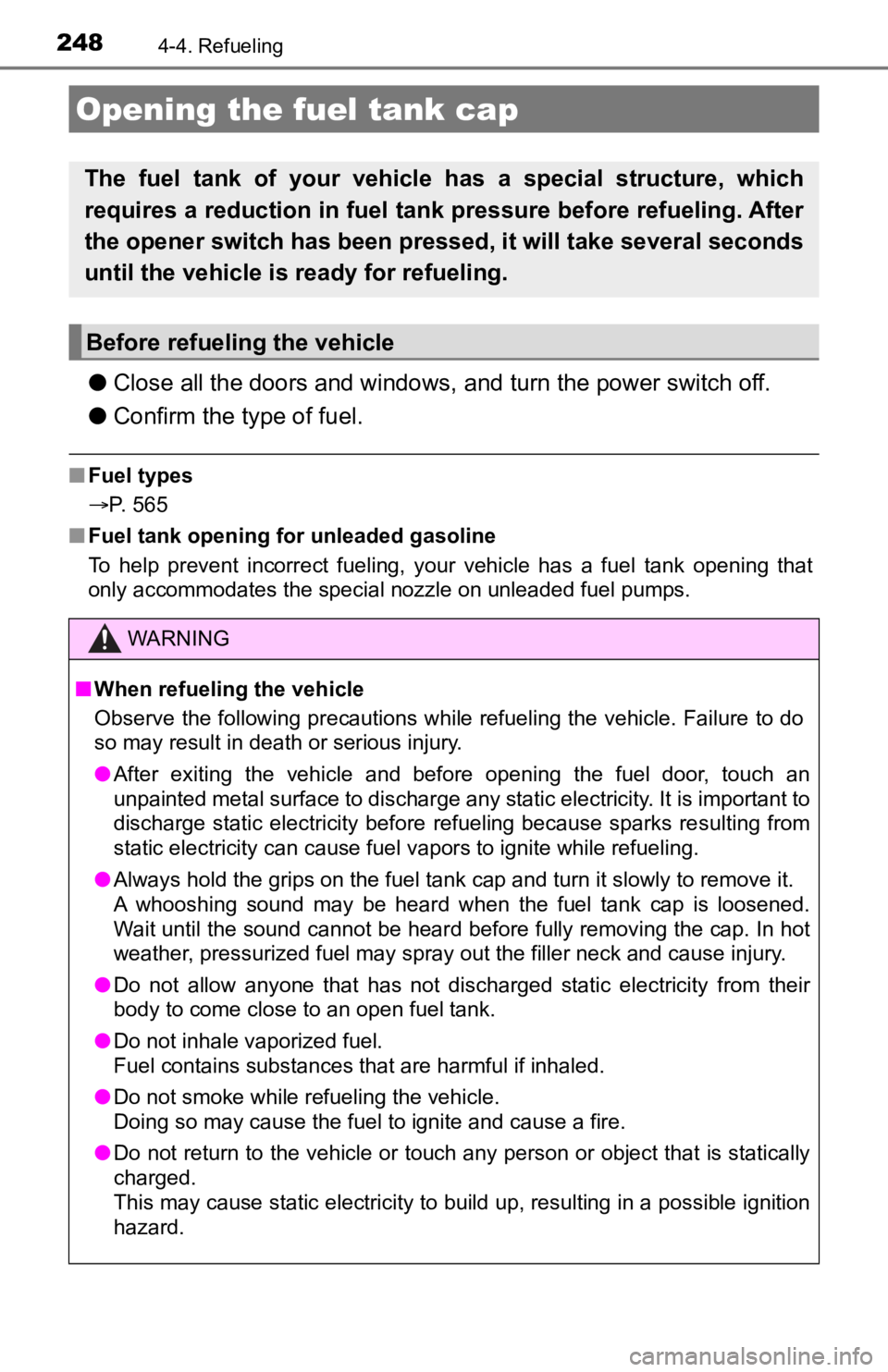
2484-4. Refueling
●Close all the doors and windows, and turn the power switch off.
● Confirm the type of fuel.
■Fuel types
P. 565
■ Fuel tank opening for unleaded gasoline
To help prevent incorrect fueling, your vehicle has a fuel tank opening that
only accommodates the special nozzle on unleaded fuel pumps.
Opening the fuel tank cap
The fuel tank of your vehicle h as a special structure, which
requires a reduction in fuel tank pressure before refueling. After
the opener switch has been pressed, it will take several second s
until the vehicle is r eady for refueling.
Before refueling the vehicle
WARNING
■ When refueling the vehicle
Observe the following precautions while refueling the vehicle. Failure to do
so may result in death or serious injury.
● After exiting the vehicle and before opening the fuel door, touch an
unpainted metal surface to discharge any static electricity. It is important to
discharge static electricity before refueling because sparks resulting from
static electricity can cause fuel vapors to ignite while refueling.
● Always hold the grips on the fuel tank cap and turn it slowly to remove it.
A whooshing sound may be heard when the fuel tank cap is loosened.
Wait until the sound cannot be heard before fully removing the cap. In hot
weather, pressurized fuel may spray out the filler neck and cau se injury.
● Do not allow anyone that has not discharged static electricity from their
body to come close to an open fuel tank.
● Do not inhale vaporized fuel.
Fuel contains substances that are harmful if inhaled.
● Do not smoke while refueling the vehicle.
Doing so may cause the fuel to ignite and cause a fire.
● Do not return to the vehicle or touch any person or object that is statically
charged.
This may cause static electricity to build up, resulting in a p ossible ignition
hazard.
Page 250 of 624
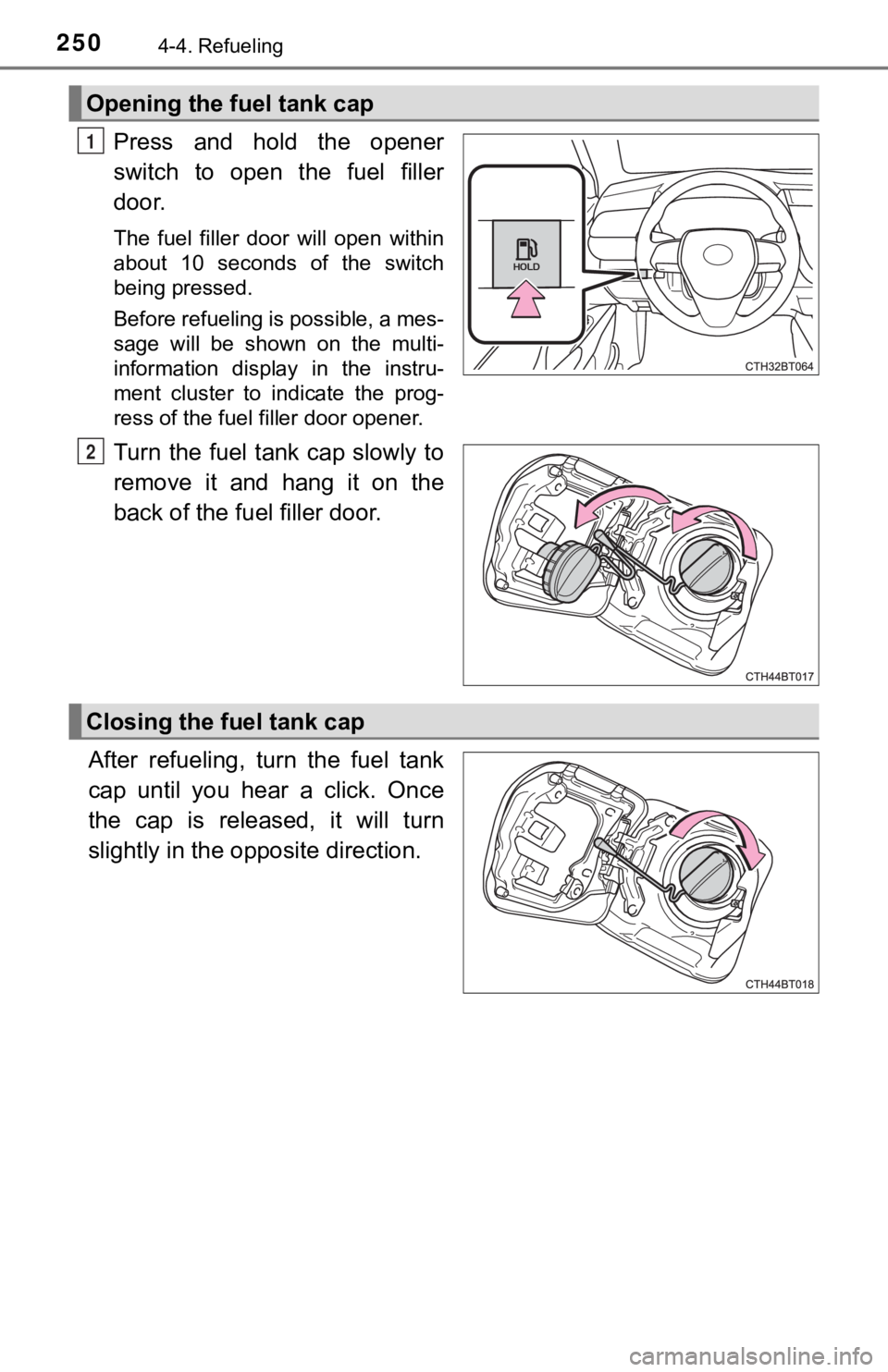
2504-4. Refueling
Press and hold the opener
switch to open the fuel filler
door.
The fuel filler door will open within
about 10 seconds of the switch
being pressed.
Before refueling is possible, a mes-
sage will be shown on the multi-
information display in the instru-
ment cluster to indicate the prog-
ress of the fuel filler door opener.
Turn the fuel tank cap slowly to
remove it and hang it on the
back of the fuel filler door.
After refueling, turn the fuel tank
cap until you hear a click. Once
the cap is released, it will turn
slightly in the opposite direction.
Opening the fuel tank cap
1
2
Closing the fuel tank cap
Page 251 of 624
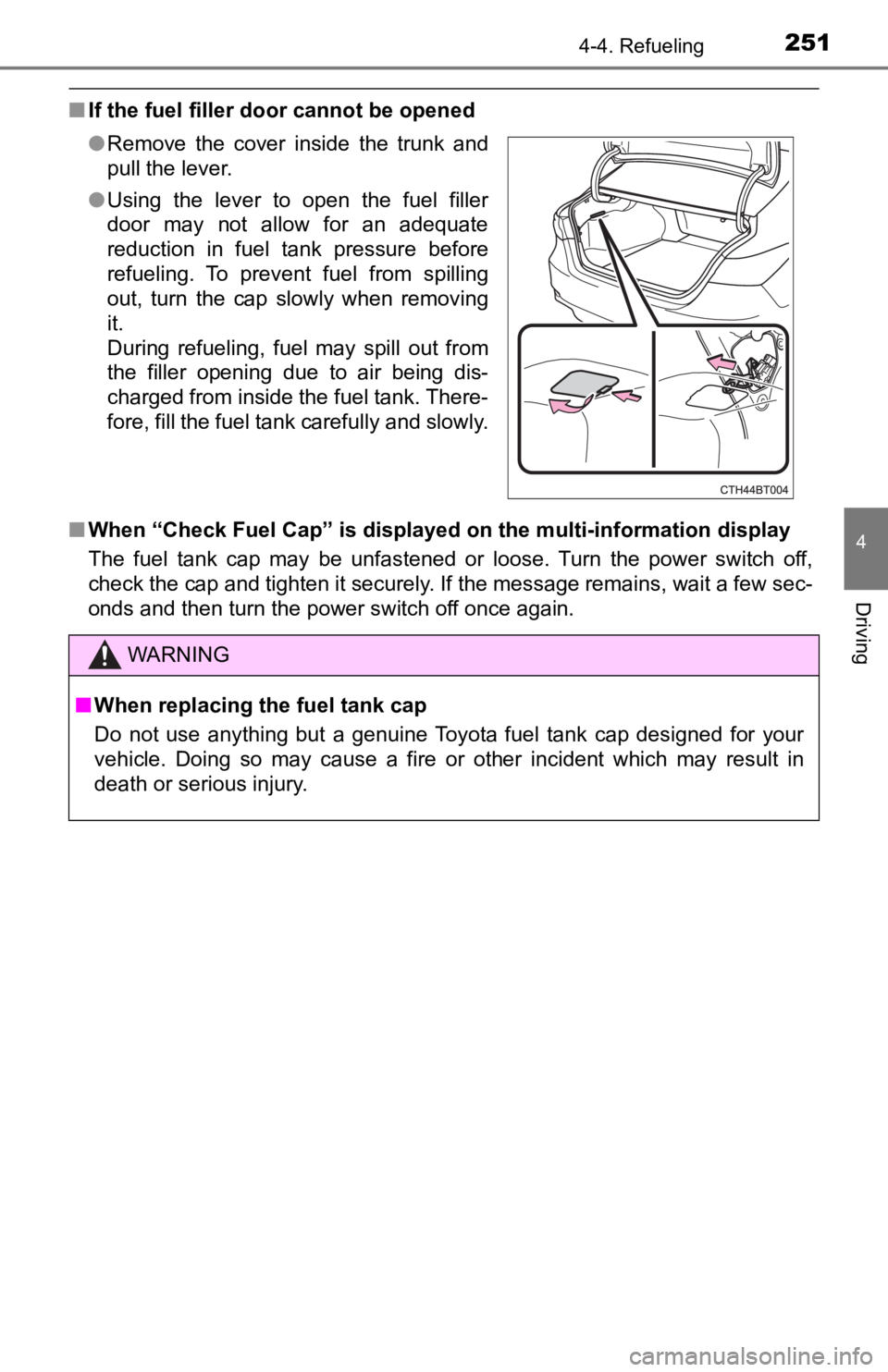
2514-4. Refueling
4
Driving
■If the fuel filler door cannot be opened
■ When “Check Fuel Cap” is displayed on the multi-information dis play
The fuel tank cap may be unfastened or loose. Turn the power sw itch off,
check the cap and tighten it securely. If the message remains, wait a few sec-
onds and then turn the power switch off once again. ● Remove the cover inside the trunk and
pull the lever.
● Using the lever to open the fuel filler
door may not allow for an adequate
reduction in fuel tank pressure before
refueling. To prevent fuel from spilling
out, turn the cap slowly when removing
it.
During refueling, fuel may spill out from
the filler opening due to air being dis-
charged from inside the fuel tank. There-
fore, fill the fuel tank carefully and slowly.
WARNING
■When replacing the fuel tank cap
Do not use anything but a genuine Toyota fuel tank cap designed for your
vehicle. Doing so may cause a fire or other incident which may result in
death or serious injury.
Page 385 of 624
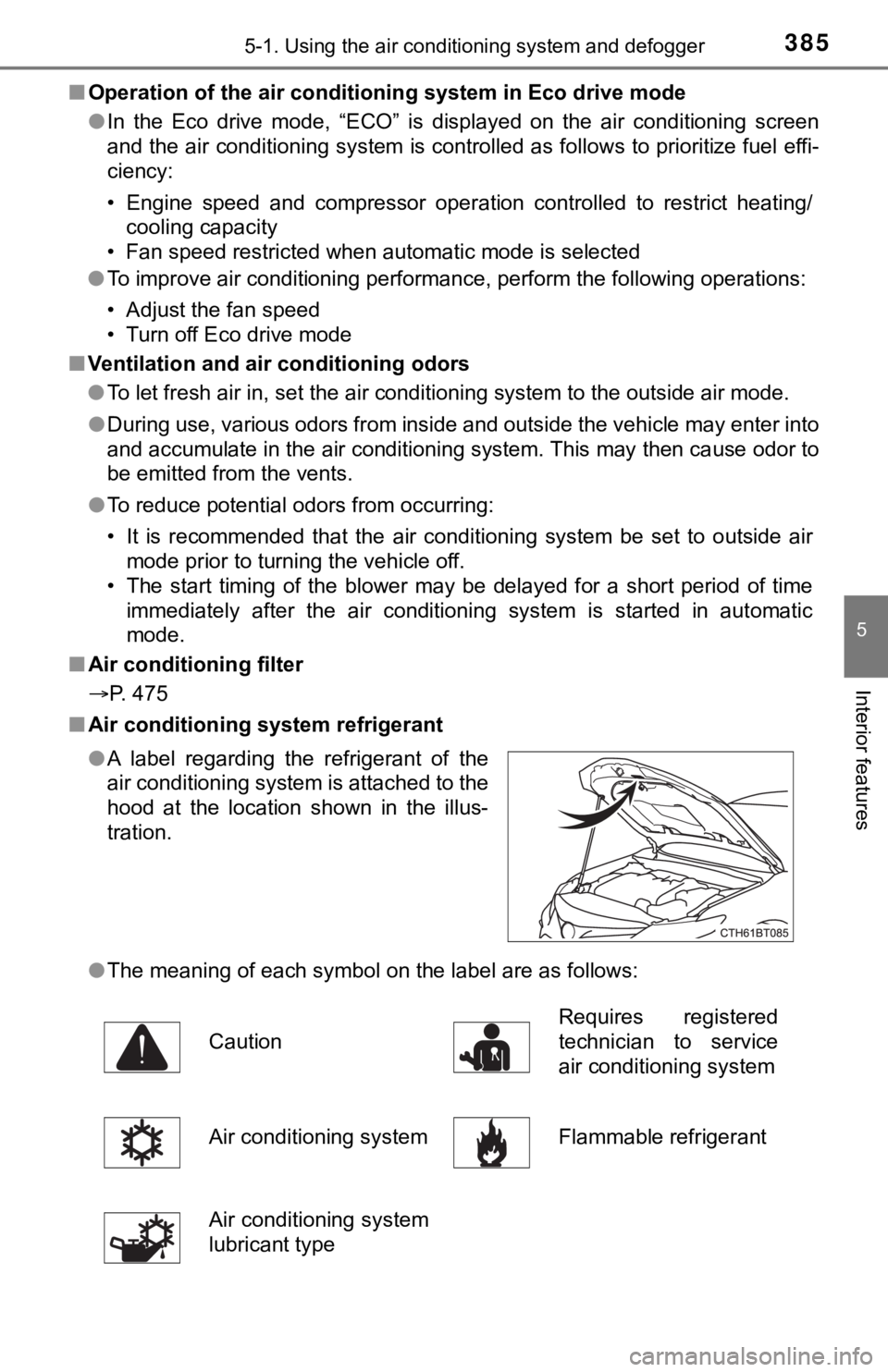
3855-1. Using the air conditioning system and defogger
5
Interior features
■Operation of the air conditioning system in Eco drive mode
●In the Eco drive mode, “ECO” is displayed on the air conditioni ng screen
and the air conditioning system is controlled as follows to pri oritize fuel effi-
ciency:
• Engine speed and compressor operation controlled to restrict h eating/
cooling capacity
• Fan speed restricted when automatic mode is selected
● To improve air conditioning performance, perform the following operations:
• Adjust the fan speed
• Turn off Eco drive mode
■ Ventilation and air conditioning odors
●To let fresh air in, set the air conditioning system to the out side air mode.
● During use, various odors from inside and outside the vehicle m ay enter into
and accumulate in the air conditioning system. This may then ca use odor to
be emitted from the vents.
● To reduce potential odors from occurring:
• It is recommended that the air conditioning system be set to o utside air
mode prior to turning the vehicle off.
• The start timing of the blower may be delayed for a short peri od of time
immediately after the air conditioning system is started in aut omatic
mode.
■ Air conditioning filter
P. 475
■ Air conditioning system refrigerant
●The meaning of each symbol on the label are as follows:
●
A label regarding the refrigerant of the
air conditioning system is attached to the
hood at the location shown in the illus-
tration.
Caution Requires registered
technician to service
air conditioning system
Air conditioning system Flammable refrigerant
Air conditioning system
lubricant type
Page 437 of 624
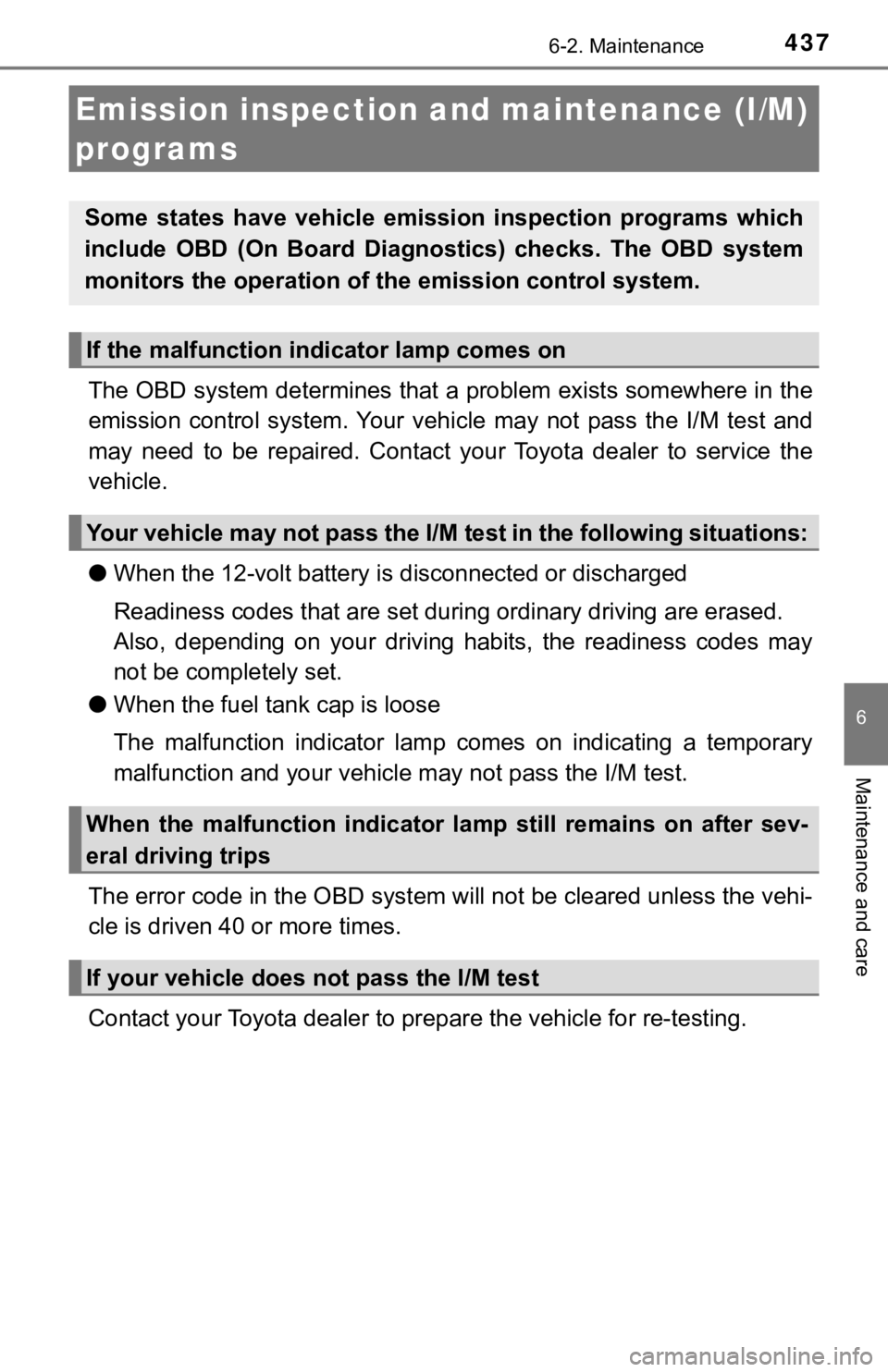
4376-2. Maintenance
6
Maintenance and care
The OBD system determines that a problem exists somewhere in the
emission control system. Your vehicle may not pass the I/M test and
may need to be repaired. Contact your Toyota dealer to service the
vehicle.
● When the 12-volt battery is disconnected or discharged
Readiness codes that are set duri ng ordinary driving are erased.
Also, depending on your driving habits, the readiness codes may
not be completely set.
● When the fuel tan k cap is loose
The malfunction indicator lamp comes on indicating a temporary
malfunction and your vehicle m ay not pass the I/M test.
The error code in th e OBD system will not be cleared unless the vehi-
cle is driven 40 or more times.
Contact your Toyota dea ler to prepare the vehicle for re-testin g.
Emission inspection and maintenance (I/M)
programs
Some states have vehicle emission inspection programs which
include OBD (On Board Diagnos tics) checks. The OBD system
monitors the operation of t he emission control system.
If the malfunction indicator lamp comes on
Your vehicle may not pass the I/M test in the following situations:
When the malfunction indicator lamp still remains on after sev-
eral driving trips
If your vehicle does not pass the I/M test